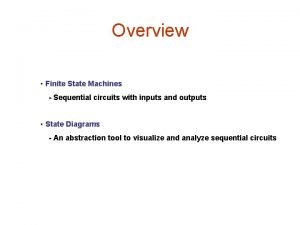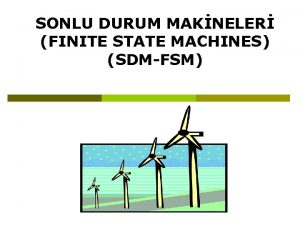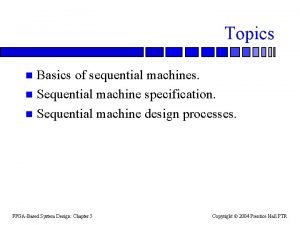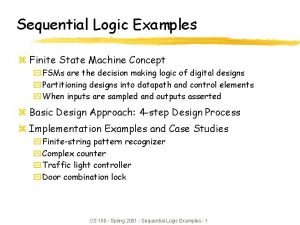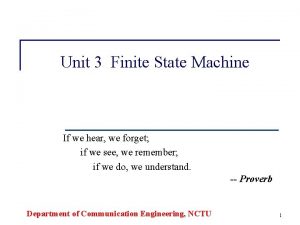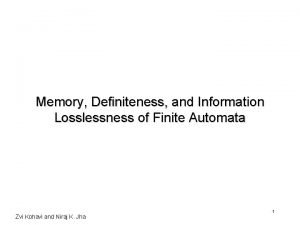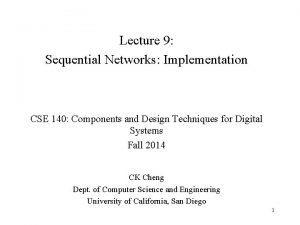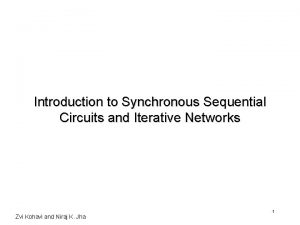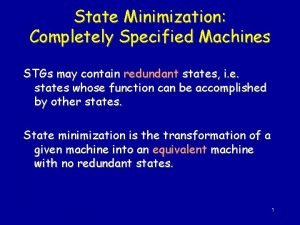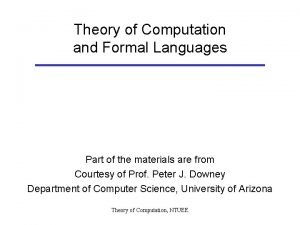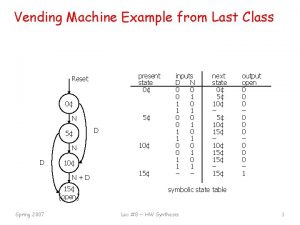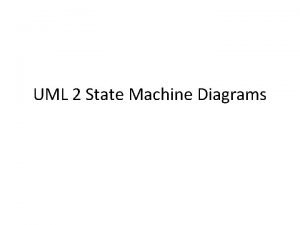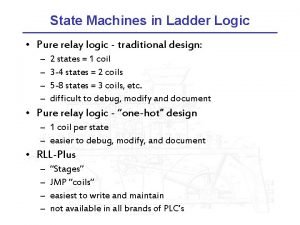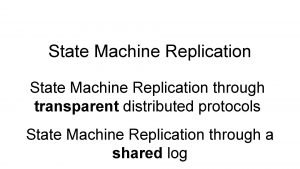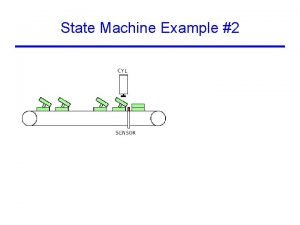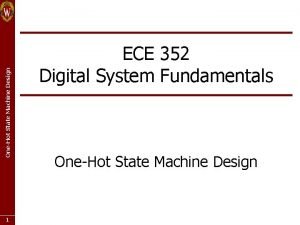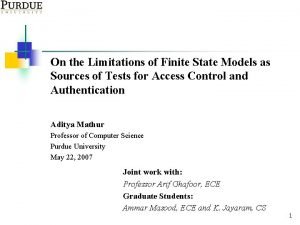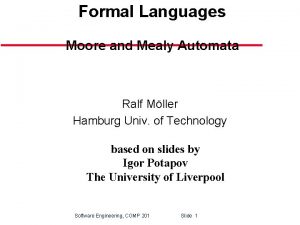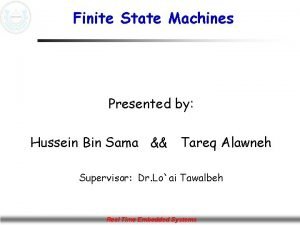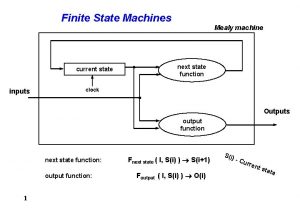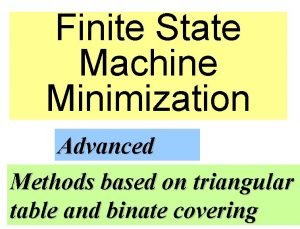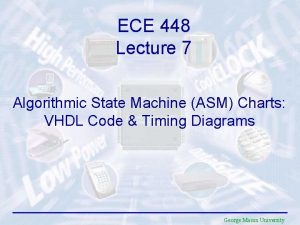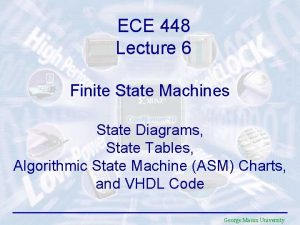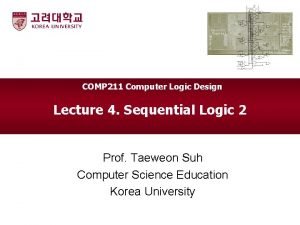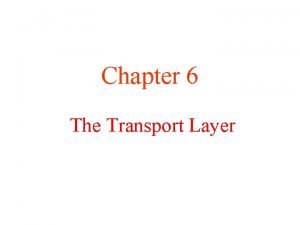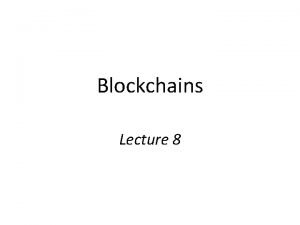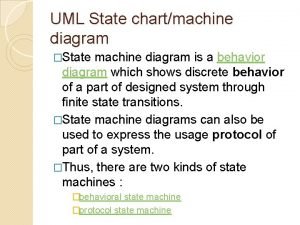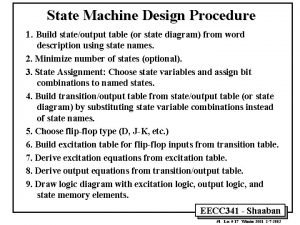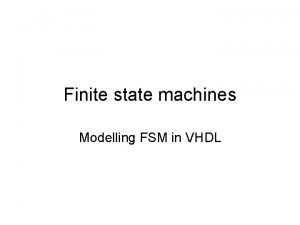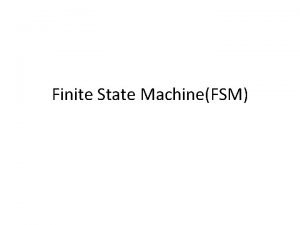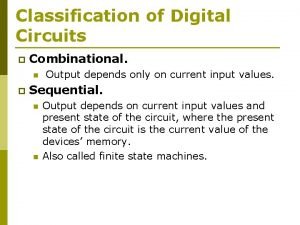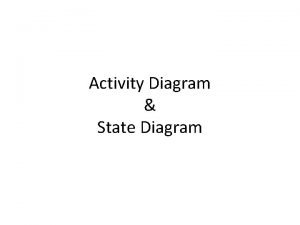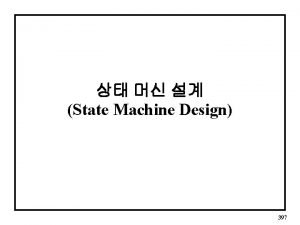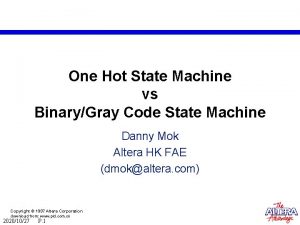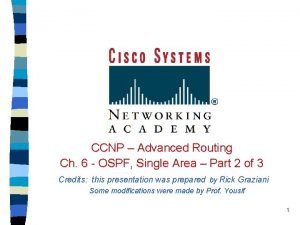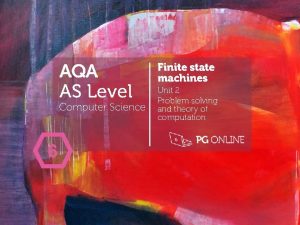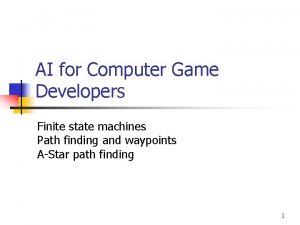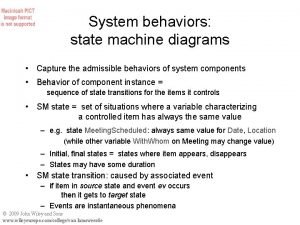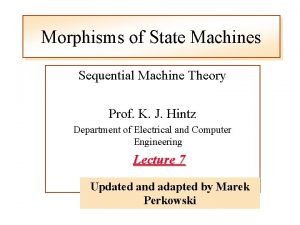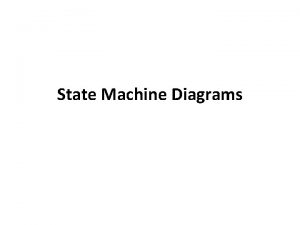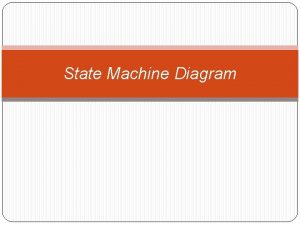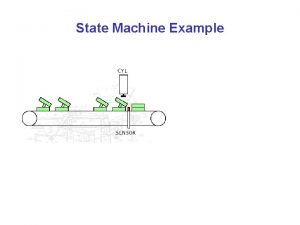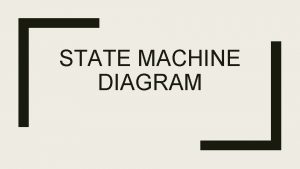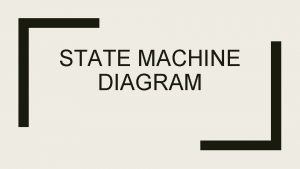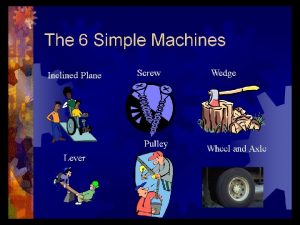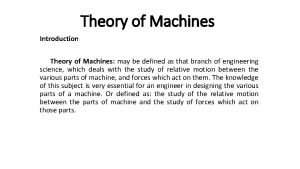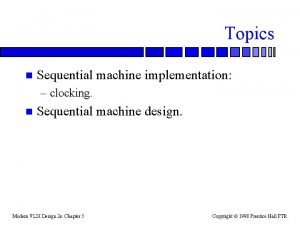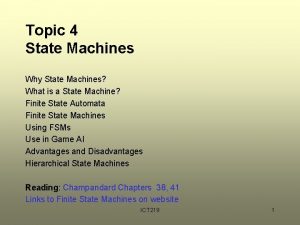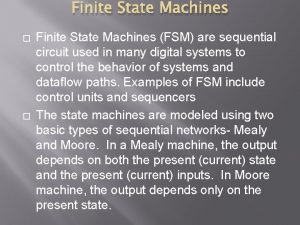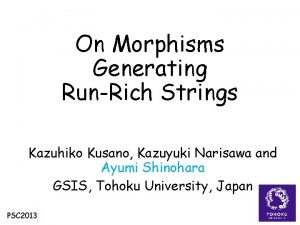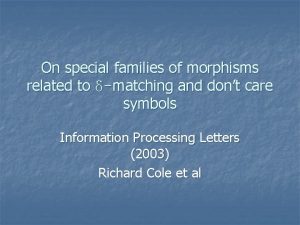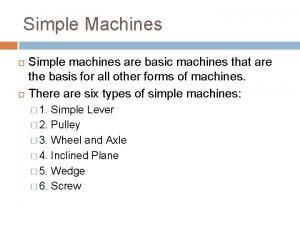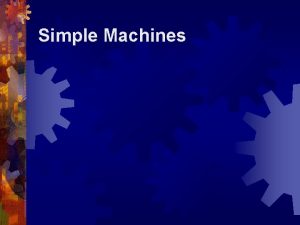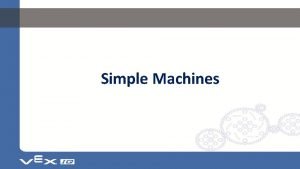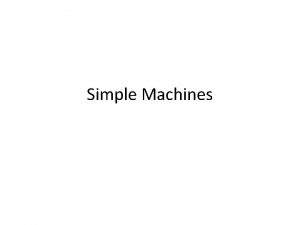Morphisms of State Machines Sequential Machine Theory Prof

















































- Slides: 49

Morphisms of State Machines Sequential Machine Theory Prof. K. J. Hintz Department of Electrical and Computer Engineering Lecture 8 Updated and adapted by Marek Perkowski

Notation

Free Semi. Group

String or Word

Concatenation

Partition of a Set • Properties • pi are called “pi-blocks” of a partition, (A)

Types of Relations • • • Partial, Binary, Single-Valued System Groupoid Semi. Group Monoid Group

Partial Binary Single-Valued

Groupoid • Closed Binary Operation • Partial, Binary, Single-Valued System with • It is defined on all elements of S x S • Not necessarily surjective

Semi. Group • An Associative Groupoid – Binary operation, e. g. , multiplication – Closure – Associative • Can be defined for various operations, so sometimes written as

Closed Binary Operation • Division Is Not a Closed Binary Operation on the Set of Counting Numbers 6/3 = 2 = counting number 2/6 = ? = not a counting number • Division Is Closed Over the Set of Real Numbers.

Monoid Semigroup With an Identity Element, e.

Group Monoid With an Inverse

‘Morphisms’ Homomorphism (J&J) “A correspondence of a set D (the domain) with a set R (the range) such that each element of D determines a unique element of R [single-valued] and each element of R is the correspondent of at least one element of D. “ and. . .

Homomorphism “If operations such as multiplication, addition, or multiplication by scalars are defined for D and R, it is required that these correspond. . . ” and. . .

Homomorphism “If D and R are groups (or semigroups) with the operation denoted by * and x corresponds to x’ and y corresponds to y’ then x * y must correspond to x’ * y’ “ Product of Correspondence = Correspondence of product

Homomorphism

Homomorphism • Correspondence must be – Single-valued: therefore at least a partial function – Surjective: each y in the R has at least one x in the D – Non-Injective: not one-to-one else isomorphism

Endomorphism • A ‘morphism’ which maps back onto itself • The range, R, is the same set as the domain, D, e. g. , the real numbers. ‘morphism’ R=D

Semi. Group Homomorphism

Semi. Group Homomorphism

Sm. Gp. Hm. Mphsm. Example* *Larsen, Intro to Modern Algebraic Concepts, p. 53

Sm. Gp. Hm. Mphsm. Example* Is the relation • single-valued? – Each symbol of D maps to only one symbol of R • surjective? – Each symbol of R has a corresponding element in D • not-injective? – e and g 4 correspond to the same symbol, 0

Sm. Gp. Hm. Mphsm. Example* Do the results of operations correspond? same

Monoid Homomorphism

Isomorphism • An Isomorphism Is a Homomorphism Which Is Injective • Injective: One-to-One Correspondence – A relation between two sets such that pairs can be removed, one member from each set until both sets have been simultaneously exhausted

Semi. Group Isomorphism Injective Homomorphism

Isomorphism Example* • Define two groupoids – non-associative semigroups – groups without an inverse or identity element • SG 1: • SG 2: *Ginzberg, pg 10 A 1 = { positive real numbers } *1 = multiplication = * A 2 = { positive real numbers } *2 = addition = +

Isomorphism Example

Semi. Group Isomorphism

Machine Isomorphisms • Input-output isomorphism, but usually abbreviated to just isomorphism • An I/O isomorphism exists between two machines, M 1 and M 2 if there exists a triple

Machine Isomorphisms

Machine Isomorphisms Interpret

Machine State Isomorphism

Machine Output Isomorphism

Homo- vice Iso- Morphism Reduction Homomorphism • Shows behavioral equivalence between machines of different sizes • Allows us to only concern ourselves with minimized machines (not yet decomposed, but fewest states in single machine) • If we can find one, we can make a minimum state machine

Homo- vice Iso- Morphism Isomorphism • Shows equivalence of machines of identical, but not necessarily minimal, size • Shows equivalence between machines with different labels for the inputs, states, and/or outputs

Block Diagram Isomorphism I 1 I 2 I 1 M 2 M 1 O 2 O 1

Block Diagram Isomorphism

Block Diagram Isomorphism which is the same as the preceding state diagram and block diagram definitions therefore M 1 and M 2 are Isomorphic to each other

Machine Information • Since the Inputs and Outputs Can Be Mapped Through Isomorphisms Which Are Independent of the State Transitions, All of the State Change Information Is Maintained in the Isomorphic Machine • Isomorphic Machines Produce Identical Outputs

Output Equivalence

Identity Machine Isomorphism

Inverse Machine Isomorphism

Machine Equivalence

Machine Homomorphism

Machine Homomorphism • If alpha is injective, then have isomorphism – “State Behavior” assignment, – “Realization” of M 1 • If alpha not injective – “Reduction Homomorphism”

Behavioral Equivalence

Behavioral Equivalence
 Finite state machine sequential circuits
Finite state machine sequential circuits Sonlu durum makinesi örnekleri
Sonlu durum makinesi örnekleri Sequential machine
Sequential machine Finite state machine vending machine example
Finite state machine vending machine example Fsm design examples
Fsm design examples Sequential machine
Sequential machine Sequential machine
Sequential machine Mealy machine
Mealy machine Sequential machine
Sequential machine Sequential machine
Sequential machine Gears sprockets pulleys
Gears sprockets pulleys Incompletely specified state machines
Incompletely specified state machines State machines digital electronics
State machines digital electronics Theory of computation
Theory of computation Moore machine and mealy machine
Moore machine and mealy machine Mealy to moore conversion
Mealy to moore conversion Differentiate between simple machine and compound machine
Differentiate between simple machine and compound machine Vending machine state diagram
Vending machine state diagram State machine diagram example
State machine diagram example Tcp segment len
Tcp segment len Quartus technology
Quartus technology State diagram to ladder logic
State diagram to ladder logic Distributed state machine
Distributed state machine State diagram for washing machine
State diagram for washing machine State machine viewer quartus
State machine viewer quartus One hot state machine
One hot state machine Limitations of finite automata
Limitations of finite automata Mealy state machine
Mealy state machine Finite state machine with datapath
Finite state machine with datapath Mealy
Mealy Finite state machine minimization
Finite state machine minimization Algorithmic state machine chart
Algorithmic state machine chart Vhdl finite state machine
Vhdl finite state machine Traffic light finite state machine
Traffic light finite state machine Transport layer primitives
Transport layer primitives What is state machine replication in blockchain
What is state machine replication in blockchain Behavioral state machine diagram
Behavioral state machine diagram State machine design
State machine design Fsm
Fsm Elevator finite state machine
Elevator finite state machine State machine design
State machine design Perbedaan activity diagram dan state machine diagram
Perbedaan activity diagram dan state machine diagram State machine diagram
State machine diagram One-hot state machine
One-hot state machine Finite state machine
Finite state machine Ospf finite state machine
Ospf finite state machine Finite state machine
Finite state machine Finite state machine game
Finite state machine game State machine diagram example
State machine diagram example Jtag state machine
Jtag state machine
